The Trans Dinarica: A new 5,500km bike trail connecting one of Europe's most remote regions
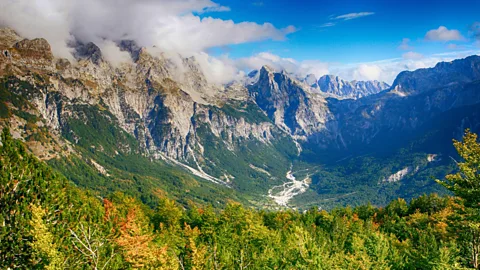 Alamy
AlamyLinking eight Balkan nations, the new Trans Dinarica cycling trail twists through some of the continent's most stunning – and least-visited – landscapes.
The asphalt vanished as the road gently climbed through the pastures. Two small dogs ran towards me from a wooden Montenegrin shepherd's hut, happily wagging their tails.
I was tempted to play with them, but a long gravel ascent lay ahead and I wanted to be on the other side of the Sinjajevina mountain before the looming storm. "Go home!", I told the dogs, worried they would get lost if they followed me, but they didn't listen. Quickly moving their tiny paws, they tirelessly kept me company until I reached the pass.
The first thunder caught me in Tušinja, a small Montenegrin village with just a handful of houses and an Orthodox church on a hill. I had no energy to pedal up another steep incline, so I hopped off and began pushing my bike when I heard a man shouting and waving at me, inviting me to his garden.
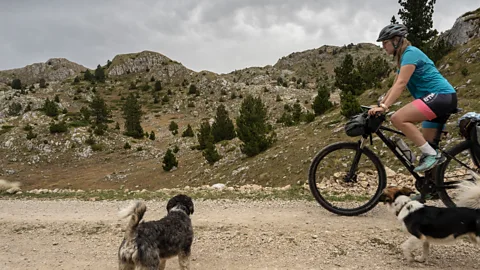 Joanna Chmara
Joanna Chmara"Coffee? Rakija?" he asked, as I leaned my bike against an apple tree and followed him inside his home. He covered the kitchen table with tomatoes, bread and cheese for me and his two workers who were laying tiles on the floor in the other room.
Through the haze of cigarette smoke, my host and his Balkan crew curiously stared at me, a rare sight in this village: a tourist.
SET OUT
Set Out is a BBC Travel series that celebrates slow, self-propelled travel and invites readers to get outside and reconnect with the world in a safe and sustainable way.
I was cycling from Podgorica, Montenegro to Sarajevo, Bosnia and Herzegovina on the Trans Dinarica, a new long-distance cycling route that officially launched in July 2024 and connects eight Balkan countries. Stretching 5,500km from Slovenia in the north to Albania in the south, the route climbs, twists and slaloms through national parks, Unesco sites and remote villages as it crosses the Dinaric Alps, one of Europe's most pristine and least-visited landscapes.
The trail was inspired by the 2,000km-long Via Dinarica, a popular long-distance hiking trail that first opened in 2010 with the goal of reconnecting people across borders of this formerly war-torn region and attracting more tourists to the Balkans' lesser-known corners. While crowds of tourists flock to coastal resorts in Croatia and Montenegro, the craggy mountains, untamed rivers and dramatic canyons of the Western Balkans remain unknown to most travellers.
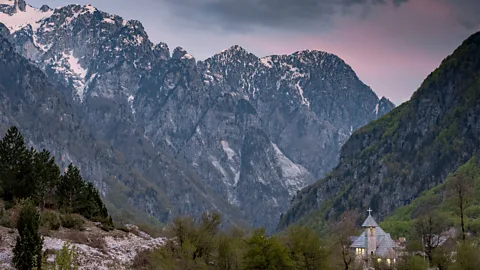 Joanna Chmara
Joanna ChmaraUnspoiled nature isn't the only appeal of the Dinaric Alps. More than 30 years after the disintegration of Yugoslavia into six separate states – and a series of ethnically driven conflicts that followed in the 1990s – the region is now a patchwork of cultures, with Catholics, Muslims, Serbs, Croats, Albanians, Slovenes and other peoples now living together as neighbours.
Examples of this Balkan multiculturalism are everywhere on the Trans Dinarica, such as in Theth, a remote village in northern Albania. Following centuries of Ottoman rule, Albania is now a predominantly Muslim nation, yet this far-flung settlement has preserved its Catholic identity. As I pedalled towards Theth's soaring church spire surrounded by majestic peaks of the Accursed Mountains, I couldn't help but feel like I was arriving in a typical Alpine village in Switzerland.
Elsewhere, ancient Hellenistic ruins, Orthodox monasteries and Ottoman cities bear witness to the Balkans' tangled history, while natural wonders – such as Montenegro's Tara River Canyon (the deepest canyon in Europe) and Lake Ohrid (Europe's oldest lake) – are found along the route.
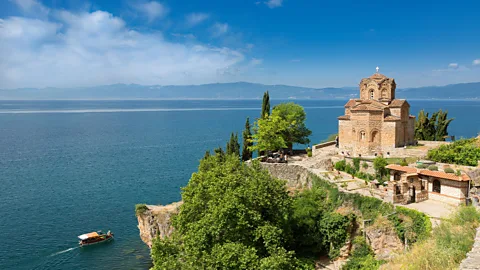 Alamy
Alamy"I was the last generation of kids who grew up in Yugoslavia, learning Serbo-Croatian with [Yugoslavian president Josip Broz] Tito's picture on the wall in the classroom," Jan Klavora, CEO of Slovenian outdoor adventure agency Visit Good Place and one of the creators of the Trans Dinarica, told the BBC. "I hope that Trans Dinarica can connect the region in a new way."
Until recently, cycling long distances in the Balkans was highly complex. During my first cycling tour through Slovenia, Croatia and Bosnia in 2018, finding information on scenic and safe routes was nearly impossible. As a result, many cyclists I met during my journeys would stick to the coastal roads, missing out on the tranquility and immersive cultural experiences to be had by travelling slowly through the mountains. But the Trans Dinarica route effectively opens up one of Europe's most remote areas to cyclists for the first time.
Planning your trip
Each stage of the Trans Dinarica ends in a village or town with at least one small inn or guest house. Local operators are available to help cyclists with planning and logistics, and "navigation packs" containing detailed information about shops, restaurants and guest houses along the route are available for purchase.
"From a database containing 27,000km of cyclable roads and trails, we chose the best 5,500km and mapped it, adding points of interest along the route," says Klavora.
Yet, the Trans Dinarica's goal isn't just to encourage cyclists to visit; its creators are also hoping to revive depopulated areas where residents have left in search of better job prospects.
"We believe that [the] Trans Dinarica can have a regenerative effect on these regions. With tourism and services starting to develop, people will have the chance to stay," says Jana Apih, the founder and sustainable tourism expert of GoodPlace.
Klavora believes that projects like the Via Dinarica and the new Trans Dinarica can help the Balkans develop sustainably and enhance community-based tourism. "We, cyclists, are slow and hungry. We visit places others do not. We are good customers," he jokes.
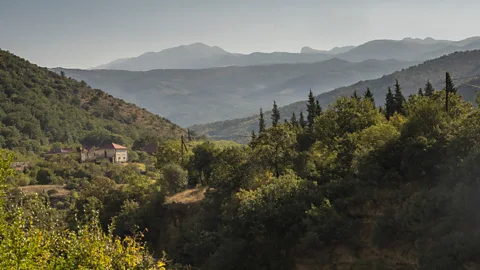 Joanna Chmara
Joanna ChmaraYet, managing tourism in these relatively remote communities is a balancing act, and Klavor and Apih are both concerned that recent developments in the region, such as the new Vlorë airport in Albania, which is scheduled to open in summer 2025, could cause more harm than good. As Apih explains, the natural landscape in much of the Balkans remains relatively untouched, and the opening of a large international airport alongside hotels, resorts and the hordes of visitors that will come with it run the risk of straining the local environment and communities.
"Thanks to [the Trans Dinarica], people understand that tourists come to the Balkans because of this pristine nature. We want to show that tourism and investment don't have to ruin the region's uniqueness," says Apih.
Cycling through the Unesco-inscribed Durmitor National Park, one of Europe's wildest and least-visited mountain ranges, I understood what she meant. These twisting mountain roads rival the most picturesque passes in the Swiss, French or Italian Alps, but with none of the crowds. Yet, I could easily imagine how, with extensive developments, ski resorts or massive hotels, this place could lose its unique sense of peace.
After a few exhausting days in Montenegro, climbing some of the highest passes of the entire Trans Dinarica, I finally crossed the border to Bosnia and Herzegovina and slowed down. In the small village of Tušila, I spent two nights at a mountain hut called Dom Vrela. I had informed Dino, the hut's caretaker, that I was a vegetarian, and when I arrived he surprised me with a hand-written list of veggie dishes available for dinner – his version of meat-free čorba (a thick bean stew) was the perfect food for a rainy day.
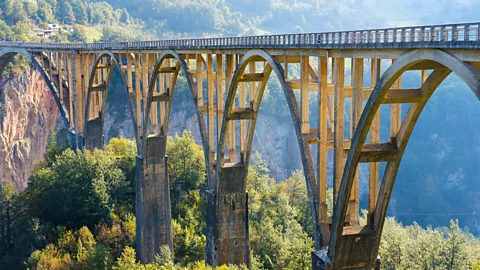 Alamy
Alamy"We have a lot of cyclists here," he told me, and a few hours later, two American couples entered the hut asking if they could charge their e-bikes.
After this two-day pause, I set out on the last stage of my adventure, across the vast Bjelašnica plateau that was sprinkled with the first snow of the season in September. Shepherds have been bringing their livestock up to this lush, open pasture for centuries. The clouds hung low above the villages of Umoljani and Lukomir, with stone houses and mysterius stećcci (ancient, engraved tombstones) resting on the edge of a dramatic cliffside.
Despite the moody, unwelcoming weather, Lukomir was filled with jovial chatter. Colourful woollen socks, hats and slippers hanging on wooden fences brightened the grey and foggy landscape. Invited by the warm smile of an elderly woman, I came closer to buy a pair of socks. "It's all handmade, 100% wool," she said. "Feel how thick and warm they are!"
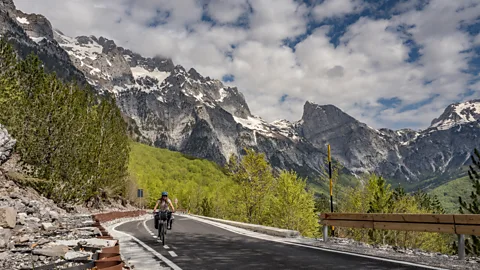 Joanna Chmara
Joanna ChmaraThese socks came in handy on the last long descent of my trip. I passed the hills where skiers raced during the 1984 Winter Olympics in Sarajevo and a thick, evergreen forest on the slopes of the Igman mountain plateau. The panorama of the city unfolded in front of my eyes – a mosaic of terracotta roofs, mosques, churches and skyscrapers; the perfect representation of the Balkans' diversity.
"We, cyclists, don't care about borders," Klavora says. "We don't care who is Bosniak, Croatian or Serb; we don't care about ethnicity or religion. We just want to explore."
--
If you liked this story, sign up for The Essential List newsletter – a handpicked selection of features, videos and can't-miss news, delivered to your inbox twice a week.
